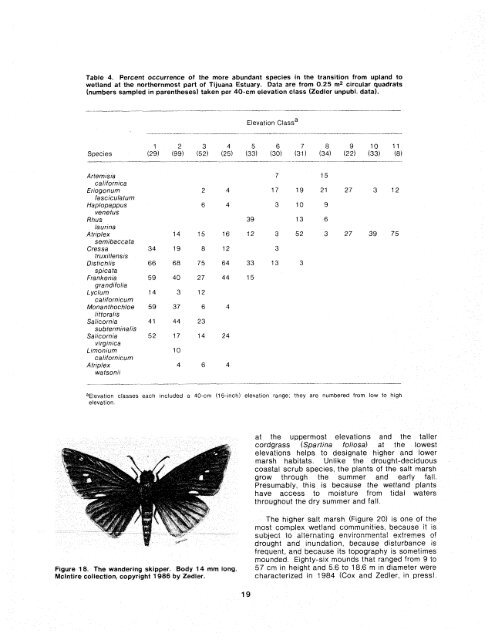The Ecology of Tijuana Estuary, California: An Estuarine Profile
The Ecology of Tijuana Estuary, California: An Estuarine Profile
The Ecology of Tijuana Estuary, California: An Estuarine Profile
Create successful ePaper yourself
Turn your PDF publications into a flip-book with our unique Google optimized e-Paper software.
Table 4. Percent occurrence <strong>of</strong> the more abundant species in the transition from upland to<br />
wetland at the northernmost part <strong>of</strong> <strong>Tijuana</strong> <strong>Estuary</strong>. Data are from 0.25 rn2 circutar quadrats<br />
(numbers sampled in parentheses) taken per 40-cm elevation class (Zedler unpubl. data).<br />
Elevation classa<br />
1 2 3 4 5 6 7 8 9 10 11<br />
Species (29) (99) (52) (25) (33) (30) (31) (34) (22) (33) (8)<br />
Artemisia<br />
californica<br />
Eriogonum<br />
fascicula tum<br />
Haplopappus<br />
venetus<br />
Rhus<br />
laurina<br />
A triplex<br />
semibacca ta<br />
Cressa<br />
truxillensis<br />
Dis tichlis<br />
spicata<br />
Frankenia<br />
grandifolia<br />
Lycium<br />
californicum<br />
Monanthochloe<br />
littoralis<br />
Salicornia<br />
subterminalis<br />
Salicornia<br />
virginica<br />
Limonium<br />
californicum<br />
Atriplex<br />
watsonii<br />
aElevation classes each included a 40-crn (16-inch) elevat~on range, they are numbered from low to h~gh<br />
elevation<br />
at the uppermost elevations and the taller<br />
cordgrass (Sparl~na folrosa) at the lowest<br />
elevations helps to designate higher and lower<br />
marsh habitats. Unlike the drought-deciduous<br />
coastal scrub species, the plants <strong>of</strong> the salt marsh<br />
grow through the summer and early fall.<br />
Presumably, th~s is because the wetland plants<br />
have access to moisture from tidal waters<br />
throughout the dry summer and fail<br />
Figure 1 8. <strong>The</strong> wandering skipper. Body 14 mm long.<br />
Nlclntire collection, copyright 1986 by Zedler.<br />
<strong>The</strong> hlgher salt marsh (F~gure 20) is one <strong>of</strong> the<br />
most complex wetland communities, because it is<br />
subject to aiternating envi:onmental extremes <strong>of</strong><br />
drought and inundation, because d~sturbance is<br />
frequent, and because its topography is sometimes<br />
mounded. Eighty-six mounds that ranged from 9 to<br />
57 cm in helght and 5.6 to 18.6 m rn diameter were<br />
characterized in 1984 (Cox and Zedler, in press)

















